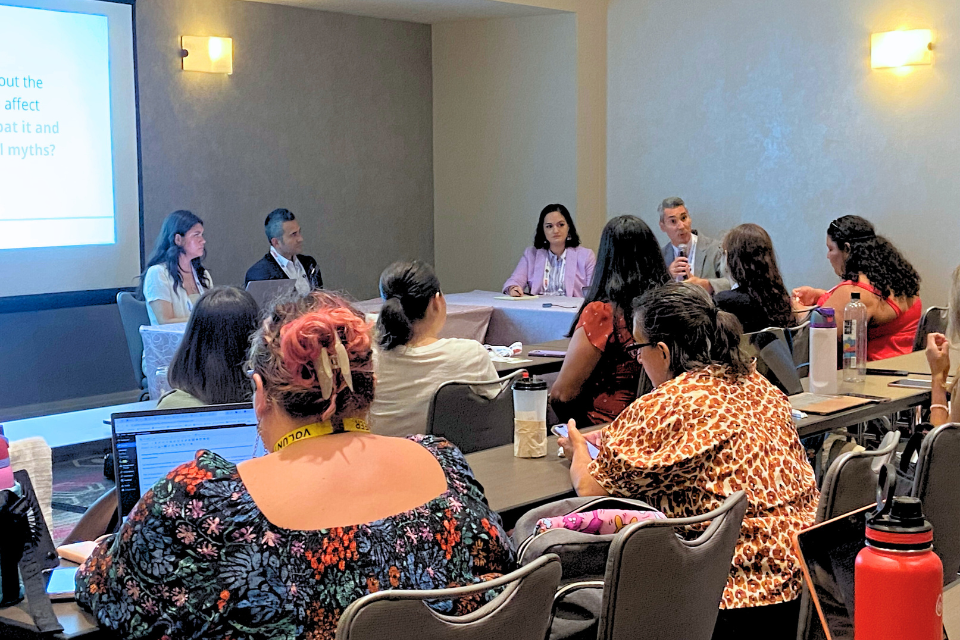State Rep. Matthew Lesser – Is he Latino?
By Wayne Jebian
CTLatinoNews.com
State Rep. Matt Lesser (D-Middletown) with his fair skin, brown hair and blue eyes, does not “look Latino” in the stereotypical way and his last name is not Spanish. Last month, when Lesser asked to join the Black & Latino caucus, there was some quiet head scratching in some corners of the State Capitol. As it turns out, Lesser’s mother came from Argentina.
State Sen. Art Linares (R-Westbrook) has a Cuban father, and as the recipient of his father’s name and some telltale genetic features, his “Latino-ness” preceded him. As the freshman senator met some of his fellow Latino lawmakers for the first time in January, he asked, “How do I join the caucus?” and was told, “You’re already in it.”
The question of who is a Latino is one the U.S. Census is grappling with. Currently, part of how the census counts Latinos is by self-identification, a method that would include Lesser, but since census officials know they can’t count every head, they factor into overall census figures an estimate based on the percentage of Spanish last names in a population pool. Had Lesser never filled in his census form, the U.S. might be short one Latino.
The Census is proposing in a controversial step to change its questions on ethnicity about Hispanics (it doesn’t use the word Latino) to now be one of race. Since 2000, people have been able to mark one or more race, but only one Hispanic ethnicity.
But it’s clear the question of who is a Latino will also be debated on many other levels. What makes someone “more” Latino than another person? It is because of a father’s or husband’s name? Where they were born? And why does this matter?
Actually, according to the Pew Hispanic Center it matters quite a bit. “The accuracy of these census population estimates is important not only because they are the major source of basic demographic data in the years between census counts, but also because they are the basis for distributing billions of dollars in federal funds during those years.”
Combine this with the political clout that was demonstrated in this last Presidential election cycle as well as the economic consumer power that is driven by numbers and the question of who counts as Latino is everyone’s concern.
In Connecticut, what can be considered one official definition for a Latino can be found in the CT General Statutes. Its definition is “Hispanic Americans is … all persons of Mexican, Puerto Rican, Cuban, Central or South American, or other Spanish culture or origin, regardless of race.” People with origins in the Iberian Peninsula, including Portugal, are considered minorities but not Hispanic by the state’s legal definition.
The Connecticut Secretary of State’s Office, however, uses easily recognizable traditional last names to identify Latino voters: a system that might raise more questions than it settles. Consider two former UConn basketball players, Rebecca Lobo and Diana Taurasi. Taurasi has two parents who grew up in Argentina before coming to the United States. Her father was born in Italy, so now the family has an Italian name.
Lobo, on the other hand, has a Cuban/Polish father and a German/Irish mother. Hair-splitters could argue that Taurasi is “more” Latina than Lobo, but it is Lobo who would be counted among the Latino/Hispanic population in census estimates. Meanwhile, both have a perfectly sound case to self-identify as Latina. Lobo’s brother, Jason, is a member of the Connecticut Hispanic Bar Association and a recently announced nominee to the Connecticut Superior Court.
And if you want to become even more technical on the usage of terms, Appeals Court Judge Carmen Espinosa, appointee to the State Supreme Court, was born in Puerto Rico. Some might consider Judge Espinosa “more” Latino than Lobo, while the census would call them equally Latino.
However, official academic definitions of Latino would exclude Espinosa. As unlikely as this sounds, it holds water because the very term, “Latino” was invented by academics.
“Latino is a word that emerged post World War II as a part of area studies,” said Charles Venator-Santiago, assistant professor of Political Science at UConn. “The intelligence and foreign service communities needed a way to study and understand Central and South American countries and their cultures for political purposes. Puerto Rico, as a U.S. protectorate, was not under this definition.”
Dr. Venator-Santiago says that by the same token, many people who came to the United States from Mexico or South America, and went through the immigration process, view the Puerto Rican experience as different enough to put them in a different category. This is where personal and official definitions tend to part ways.
The Merriam-Webster dictionary restricts “Latino” to Latin America, which excludes Portugal, Brazil, and Spain.
Do the Spaniards agree with this definition? “Latino is a term which refers to people from Spanish-speaking South America, or to cultural traits from that area, such as ‘musica latina’,” confirmed Dr. Francisco Linares, associate professor of sociology at the Universidad de La Laguna in Tenrife, in the Spanish Canary Islands. “If I went abroad I would never refer myself as ‘Latino’, I’d always say ‘I am Spanish’ or ‘I am from Spain’. Nevertheless, Spaniards may speak about themselves as ‘Latinos’, especially when talking about some cultural aspect influenced by Latino Americans.”
The term Latino has evolved over the years and is still used interchangeably with the term Hispanic in this country and generally, the use of the two terms is a matter of regional and personal preference in terms of self-identification. As the Latinos in the U.S. have increased in numbers, many have adopted the term as a kind of solidarity with anyone of Spanish-speaking origin and an “otherness” in relation to an Anglo cultural mainstream in the United States. “I think that the Latino community is happy to include anyone who feels that they’ve grown up in an environment where they’ve cherished Latino values,” said Senator Linares. “For me, that’s the case.”
Still, individuals often do a gut check about whether they feel “Latino enough” to self-identify. “In the last Census, I chose to identify myself as a Latino,” said Rep. Lesser, who still doesn’t know if he’s in the Black & Latino caucus, “but my experience seems different from many Latinos. As a man with fair skin and blue eyes who was born in this country, I have never had to fight the baggage of racial discrimination on the basis of Indian or African ancestry. For that reason, when asked on job and college applications, I have never identified myself as Latino.”
Marie (Virella) Basche, director of the Academic Success Center at Capital Community College, cited other complicating factors, asking, “Once you are second or third generation Latino, who defines how Latino you are? Does it have to be that you speak Spanish?”
When asked, most Latinos subscribe to a very expansive definition, caring less for the academic origins of the term, or even census definitions, focusing instead on the root, “Latin.” Taking this interpretation to a liberal extreme, Cuban-American artist Humberto Castro-Cruz said, “The real definition wasn’t created by the American [government}. Latinos are the people that come from the Roman Empire. So Latinos, by the language, are the people who speak the five Roman languages: Spanish, Portuguese, French, Italian and Romanian. All of us are Latinos. So the concept of Latinos that we have in the United States are mostly the people who come from Latin America, but Italians, and Italian-Americans are Latinos.”
The question of who is really a Latino brings never ending viewpoints from Latinos and non-Latinos alike. CTLatinoNews.com asked Lillian Martinez, professor of psychology at Hartford’s Capital Community College. Martinez tried her best not to commit to an answer, but did say, “I’m not crazy about that ‘o’ at the end.” Yet another twist.
So what is the definition? The Census thinks it will have the answer to that question in the next five years. Stay tuned.



